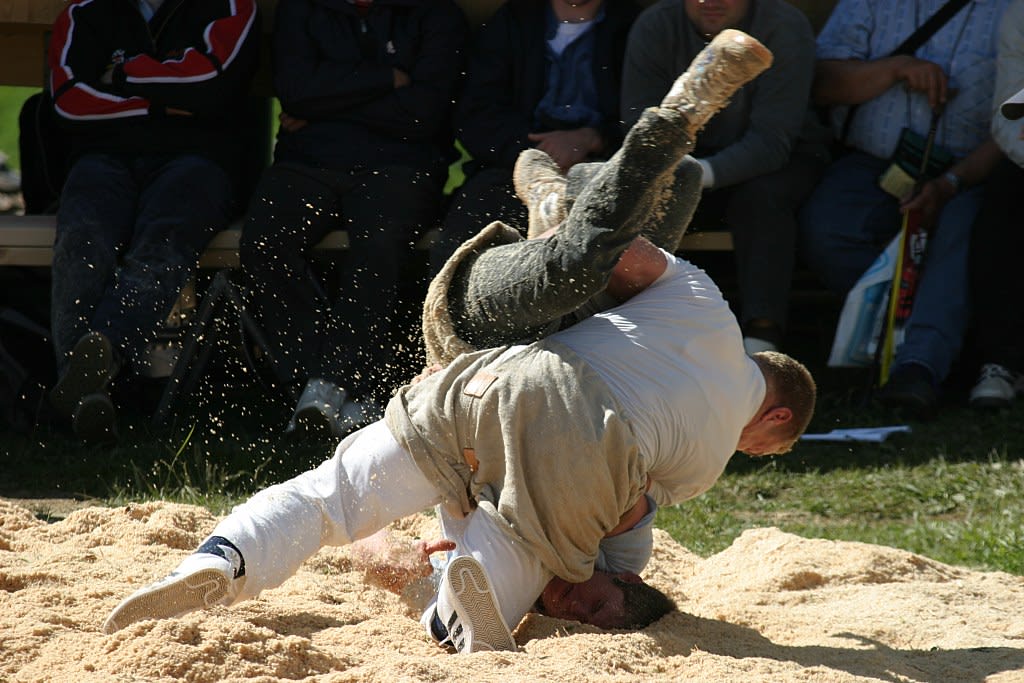
A supposedly ancient and traditional sport, Schwingen has always indisputably defended against prized imported games and played against the pathetic humps on his bicycle. The Swiss game was conceived as a fight between two strong opponents and created its own rules, tricks, and throws.
Since the late Middle Ages, Hirtenfest and competitions have been held in the Alps of central Switzerland, in which wrestlers would take part in Schwingen. In the 19th century, Swiss wrestling was introduced to the city through wrestling festivals and sports coaches. They became educated citizens around 1805, and in the following decades, they brought local rural sports to the cities and promoted them to the national games of Switzerland. The decisive factor for the success and revival of Schwingen in the late 19th century was a close sporting alliance with another city activity, gymnastics.
The first Alpine Shepherd's Day, held in Unspawn in 1805, marked the beginning of the revival of the sport of Schwingen in Switzerland from the agony of French rule. The main goal of the festival is to strengthen Switzerland's national identity.
The famous Bozen ("villains" - best wrestlers) from all over Switzerland channel their energies into festivals in Schwingen, and the national wrestling festival and alpine festival (held every three years) select a wrestling champion. Schwingen differs from competitive wrestling in that all grips are fixed, and wrestlers wear jerseys or shirts and long trousers, over which jute shorts are worn for wrestling. Schwingen rule. Participants in this Swiss version of wrestling wear special canvas shorts over their pants that have a slit in the back that allows the opponent to grab the belt.
Schwingen - Swiss wrestling; Participants wrestled in Schwinghausen (special jute pants that looked like Daisy Dukes) and brown rings. In fact, Schwingen is a fight that takes place in the Ring of Sawdust.
This comes from the movement in the game, the changes (swing), where you grab your opponent's pants and try to throw them on his back. Schwingen is a type of wrestling in which both athletes wear a Zwilch hose (drill). It is a full-blown combat sport, the goal of which is to make the opponent touch the ground with his shoulders.
Schwingen has traditionally been a men's sport only but has recently become available to women as well. Schwingen is a male-dominated sport in the national festival, even though women participate in large numbers. Schwingen is considered the "national sport" of Switzerland, along with Hornusen and Steinsthausen.
According to the "Swiss History Dictionary", the Schwingen movement is associated with stone-throwing and to some extent Hornusen and is one of the so-called national movements in Switzerland. "Schwingen is an ancient sport that has existed for a long time. Schwingen is an ancient sport that has existed for a long time. Swiss wrestling is an amateur sport with strict sponsorship rules. There is no advertising in the wrestling field. The exact date of origin of Schwingens is indeed difficult to determine.
The origins of Schwingen (or Hosenlupf, as it is also called) date back to the Middle Ages. The origins of Schwingen (or Hosenlupf, as it is also called) date back to the Middle Ages. However, while the sport is dominated by men and has its roots in the harsh Swiss farms of the Middle Ages, Schwingen is slowly progressing over time, with more and more women entering the ring. Today, even a traditional Swiss sport such as Schwingen, a form of wrestling, is a cash cow.
When traditional Schwingen is practiced today, in its distinctive combination of professionalism, marketing, and Swiss, the sport reaches audiences of unexpected sizes. "Press, radio, and television have introduced people to the sport," he says, adding that Swiss Schwingen has "developed imaginatively", thanks to huge media interest. For 44 years, Schwingfest has attracted audiences from all over the world who come to enjoy wrestling events and traditional Swiss festivals such as yodeling and Swiss folk music.
Although local matches and competitions are held regularly, the Holy Grail of Schwingen is the popular Eidgenische Schwing- und Alpplerfest (ESAF) festival. It is a festival of traditional Swiss sports that takes place every three years in different regions of Switzerland. From 30 August to 1 September, Burgdorf, the capital of the Emmental region, welcomes over 250,000 spectators to the Federal Festival of Alpine Wrestling and Games, held every three years to find the national champion, Schwinger. In fact, the Swiss Federal Wrestling and Mountaineering Festival (ESAF), which takes place every 3 years and is scheduled for 2022, is the biggest sporting tournament in Switzerland.
Charlie Inglefield, the producer of sporting events based in Zug, gives us an insight into the sport that is gaining popularity in elegant Switzerland. Charlie Inglefield, a sports journalist based in Zug, provides us with information about the increasingly popular sport in Switzerland today. Schwingen is a popular sport that originated in the German-speaking region of Switzerland.
Wrestling, known as Schwingen, is one of several traditional Swiss sports, which include Hornusen and Steinsthausen. This is why Schwingen, known as traditional Swiss wrestling, has a unique place in Swiss sport and culture. Indeed, the Swiss Federal Wrestling and Mountaineering Festival (ESAF), which takes place every three years and is scheduled for 2022, is Switzerland's biggest sporting event.
When it comes to Switzerland, sport is not what comes to mind. All countries have a sport that has certain traditions or is very popular. This list includes some of the world's most famous and some of the traditional sports that have been prized by Swiss generations (and which foreigners have never heard of).
Last but not least, we have a traditional Swiss mountain sport that has retained its values for many years. Although the latter is not popular in football, skiing, tennis, and ice hockey, Hornussen and Schwingen are attractive to the Swiss, especially in terms of cultural value to tourists. There are many customs and traditions associated with Swiss wrestlers and wrestling teams. The Association (founded in 1895) organizes sports and raises standards by integrating regional differences, providing educational materials and teaching curricula, and devising modern competition rules.
Swiss sport in Schwingen is an amateur sport and the rules for sponsorship and advertising at competition sites are very strict. Schwingen is very popular in Switzerland, but the sport is amateur in nature, although the athletes are nationally renowned.
This is why Schwingen – as it is understood in Swiss traditional wrestling – holds an exceptional place in Swiss tradition and entertainment. Indeed, in recent decades, it has become one of the most famous traditional sports in Switzerland. Unlike the above sports, Swiss tennis has become more popular in recent years due to the attractiveness of experienced athletes.





Comments
There are no comments for this story
Be the first to respond and start the conversation.